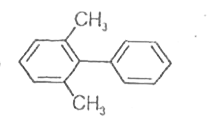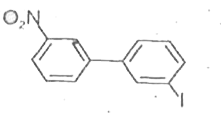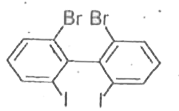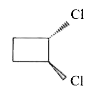Which of the following biphenyls is optically active?




The correct Answer is:C
To determine which biphenyl is optically active, we need to follow these steps:
Step 1: Understand Optical Activity
Optical activity requires the presence of a chiral center (a carbon atom bonded to four different groups) and the absence of a plane of symmetry.
Hint: Look for chiral centers and symmetry in the structures.
Step 2: Analyze Each Option
We will analyze each biphenyl option provided to check for chirality and symmetry.
Option A:
- In this biphenyl, there are two methyl (CH₃) groups at the ortho positions on the same phenyl ring.
- Since both groups are identical, this biphenyl has a plane of symmetry and is optically inactive.
Hint: Identical groups at chiral centers lead to symmetry.
Option B:
- This biphenyl has no substitutions at the ortho positions.
- It remains planar, allowing for a plane of symmetry to be drawn through it. Thus, it is optically inactive.
Hint: A planar structure with no substitutions at chiral centers has symmetry.
Option C:
- Here, we have bromine (Br) and iodine (I) at the ortho positions on both phenyl rings.
- The presence of different groups at the ortho positions means that when the biphenyl rotates around the single bond, the two phenyl rings become perpendicular to each other.
- This configuration prevents a plane of symmetry from being drawn, making this biphenyl optically active.
Hint: Different groups at chiral centers can lead to optical activity if steric hindrance occurs.
Option D:
- In this biphenyl, there are iodine (I) substituents at the ortho positions on both phenyl rings.
- Since both substituents are identical and located on opposite sides, this biphenyl is planar and has a plane of symmetry, rendering it optically inactive.
Hint: Identical substituents on opposite sides lead to symmetry.
Step 3: Conclusion
After analyzing all options, we find that Option C is the only biphenyl that is optically active due to the lack of a plane of symmetry and the presence of different groups at the ortho positions.
Final Answer: Option C is optically active.
Optical activity requires the presence of a chiral center (a carbon atom bonded to four different groups) and the absence of a plane of symmetry.
We will analyze each biphenyl option provided to check for chirality and symmetry.
- In this biphenyl, there are two methyl (CH₃) groups at the ortho positions on the same phenyl ring.
- Since both groups are identical, this biphenyl has a plane of symmetry and is optically inactive.
- This biphenyl has no substitutions at the ortho positions.
- It remains planar, allowing for a plane of symmetry to be drawn through it. Thus, it is optically inactive.
- Here, we have bromine (Br) and iodine (I) at the ortho positions on both phenyl rings.
- The presence of different groups at the ortho positions means that when the biphenyl rotates around the single bond, the two phenyl rings become perpendicular to each other.
- This configuration prevents a plane of symmetry from being drawn, making this biphenyl optically active.
- In this biphenyl, there are iodine (I) substituents at the ortho positions on both phenyl rings.
- Since both substituents are identical and located on opposite sides, this biphenyl is planar and has a plane of symmetry, rendering it optically inactive.
After analyzing all options, we find that Option C is the only biphenyl that is optically active due to the lack of a plane of symmetry and the presence of different groups at the ortho positions.
Topper's Solved these Questions
- HALOALKANES AND HALOARENES BOOK - AAKASH INSTITUTE ENGLISHCHAPTER - HALOALKANES AND HALOARENES EXERCISE - ASSIGNMENT SECTION -D
15 Videos
- HALOALKANES AND HALOARENES BOOK - AAKASH INSTITUTE ENGLISHCHAPTER - HALOALKANES AND HALOARENES EXERCISE - ASSIGNMENT SECTION - B
25 Videos
- GENERAL PRINCIPLES AND PROCESSES OF ISOLATION OF ELEMENTSBOOK - AAKASH INSTITUTE ENGLISHCHAPTER - GENERAL PRINCIPLES AND PROCESSES OF ISOLATION OF ELEMENTSEXERCISE - Try Yourself
33 Videos
- HYDROCARBONSBOOK - AAKASH INSTITUTE ENGLISHCHAPTER - HYDROCARBONSEXERCISE - Assignment(Section - C) (Previous Years Questions)
60 Videos
Similar Questions
Knowledge Check
Which of the following compounds is optically active?
A B
B C
C D
D
Which of the following compounds is optically active?
A B
B C
C D
D
Which of the following compounds is optically active ?
A1-BromobutaneB2-BromobutaneC1-Bromo-2-methylpropaneD2-Bromo-2-methylpropane
Which of the following complex is optically inactive
View SolutionPresence of chiral center is not an essential condition to show optical isomerism. Essential condition is, compound should show non-superimposable mirror image.
Allenes do not contain chiral center but show optical isomerism when different groups are attached on double bonded carbons.
Biphenyls also show optical isomerism when both rings are perpendicular to each other and any ring should not contain plane of symmetry.
Which of the following compounds is optically inactive?
View SolutionWhich of the following compound is optically inactive ?
View SolutionWhich of the following compounds is optically inactive?
View SolutionPresence of chiral center is not an essential condition to show optical isomerism. Essential condition is, compound should show non-superimposable mirror image.
Allenes do not contain chiral center but show optical isomerism when different groups are attached on double bonded carbons.
Biphenyls also show optical isomerism when both rings are perpendicular to each other and any ring should not contain plane of symmetry.
Which of the following biphenyl compounds is optically active?
View Solution
